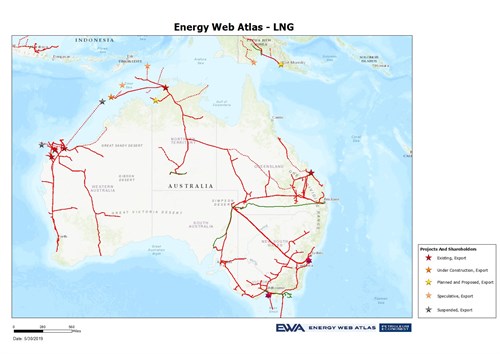'It's time to tell our story': Australia's LNG industry finally fights
It’s taken a while but Australia’s liquefied natural gas (LNG) industry is putting on the gloves and stepping into the ring against the activists who want to condemn it and all fossil fuels to history’s dustbin.
 |
| Source: EWA |
Australia’s LNG industry is now the largest in the world by capacity, having overtaken Qatar as the last of eight new projects prepares to start up, taking the country’s annual export capacity to more than 80 million tonnes of the super-chilled fuel.
But the LNG industry, for all its success in building plants and discovering natural gas reserves to feed them has been largely silent when it comes to tackling the increasing focus of green activists, who view natural gas as the next enemy to tackle after coal.
It has also suffered a public relations setback by being labeled as partly responsible for the sharp rise in domestic natural gas prices in Australia’s populated east coast, which coincided with the start-up of three LNG plants in eastern Queensland state.
While it’s way too simplistic to conclude that the LNG plants were behind the price rise, the industry has struggled to communicate that it was a range of factors, including the depletion of traditional gas supplies, policy confusion and the restriction of exploration in some states that combined to cause the current price crisis.
Previous APPEA events have largely focused on how the industry was developing, the challenges of building cost-effective LNG projects and how the industry should lobby government for consistent and favorable policy outcomes.
But the plenary session of this year’s event on Tuesday showed a sharp turn in thinking, with the launch video proudly proclaiming: “It’s time to tell our story. On our terms.”
APPEA chairman Zoe Yujnovich, who is also chairman of Royal Dutch Shell’s Australian business, said the industry has to be more proactive in fighting its corner.
“We need to keep advocating for the role of gas and not become complacent about its critical role in supplying cleaner energy across the nation and to the world,” she told the conference.
“We can’t afford to rest. Our opponents are well orchestrated, well-funded and well-drilled on tactics aiming to destroy an industry that has been an overwhelming force for good,” Yujnovich said.
HOW WILL THE INDUSTRY FIGHT?
It will be interesting to see what this new-found desire to take a higher public profile will entail for the industry, with likely targets being an increased social media presence.
The industry will also want to lobby the federal and state governments to be more supportive of exploration, as it sees boosting supply as the surest way to lower costs for domestic consumers, and it is opposed to government intervention to reserve gas for local consumption.
Australia’s LNG industry is also likely to try and counter some of the arguments advanced by environmentalists, such as the view that the emissions created by extracting and liquefying natural gas mean Australia won’t make its climate targets.
Woodside Energy Chief Executive Peter Coleman said it was time to acknowledge that the industry creates emissions in Australia, but the overall impact of its LNG on global emissions is positive, assuming the fuel is used to replace more polluting coal, as is currently the case in China.
For an industry that was largely reactive, Coleman said the time is now to become more proactive.
“In order to be around for the long term, we need to take some no-regrets actions now, including investing in abatement and offsets and developing our complementarity with renewables and batteries,” Coleman told the conference.
A consistent theme was that natural gas should be viewed as the partner for renewables in power generation, given its ability to act as a peaking power generator and thus smooth out the intermittent nature of solar and wind power.
Such a view will put the industry squarely in the sights of much of the environmental lobby, which favors a rapid transition to a 100% renewable energy system, with batteries and perhaps pumped hydro providing the backup.
For the LNG industry to win the hearts and minds battle it will have to rely on convincing what Prime Minister Scott Morrison calls the “quiet Australians.”
These are the people who don’t speak up and express opinions on social media, or attend protests, but instead want cheaper electricity and energy security.
It is becoming part of Australian political folklore that this group were behind Morrison’s surprise election victory on May 18, when he had been expected to surrender government to the opposition Labor Party, which was leading all the opinion polls but actually lost seats in the general election.
Editing by Richard Pullin,
Russell, Reuters

- ExxonMobil halts 1-Bft3d blue hydrogen project in Texas
- Aramco and Yokogawa commission multiple autonomous control AI agents at Fadhili gas plant
- Ukraine will resume gas imports via Transbalkan route in November
- Mitsubishi to inject $260 MM into Brunei LNG project
- Freeport LNG (U.S.) on track to take in more natgas on Thursday after unit outage



Comments